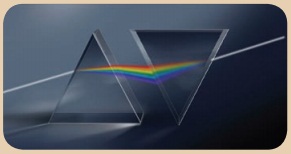Light | Chapter 3 | 8th Science - Dispersion | 8th Science : Chapter 3 : Light
Chapter: 8th Science : Chapter 3 : Light
Dispersion
Dispersion
Activity 7
Place a prism on a
table and keep a white screen near it. Now, with the help of a torch, allow
white light to pass through the prism. What do you see? You can observe that
white light splits into seven colored light rays namely, violet, indigo, blue,
green, yellow, orange and red (VIBGYOR) on the screen. Now, place another prism
in its inverted position, between the first prism and the screen. Now, what do
you observe on the screen? You can observe that white light is coming out of
the second prism.

Answer:
Aim : To understand about dispersion of light.
Materials
required : Prism - 2, white screen, torch light.
Procedure
:
(i) Place a prism on a table and keep a white screen near it.
(ii) Now with the help of a torch, allow white light to pass
through the prism. What do you see?
(Hi) Now, place another prism in its inverted position, between
the first prism and the screen. What do you observe on the screen?
Observation
I : We can observe that white light splits into seven coloured
light rays namely, violet, indigo, blue, green, yellow, orange and red
(VIBGYOR) on the screen.
Observation
II : (After placing second prism)
(i) We can observe that white light is coming out of the second
prism.
(ii) The first prism splits the white light into seven coloured
light rays and the second prism recombines them into white light again.
Inference
: It is clear that white light consists of seven colours.
Conclusion
: Splitting of white light into its seven constituent colour, on
passing through a transparent medium is known as dispersion of light.
In this activity, you can see that
the first prism splits the white light into seven coloured light rays and the
second prism recombines them into white light, again. Thus, it is clear that white light consists of
seven colours. You can also recall
Newton’s disc experiment, which you
studied in standard VII.
Splitting of white light into its
seven constituent colours (wavelength), on passing through a transparent medium
is known as dispersion of light.
Why does dispersion occur? It is
because, light of different colours present in white light have different
wavelength and they travel at different speeds in a medium. You know that
refraction of a light ray in a medium depends on its speed. As each coloured
light has a different speed, the constituent coloured lights are refracted at
different extents, inside the prism. Moreover,
refraction of a light ray is inversely proportional to its wavelength.
Thus, the red coloured light, which
has a large wavelength, is deviated less while the violet coloured light, which
has a short wavelength, is deviated more.
The formation of
rainbow is an example of dispersion of white light. This can be seen on the
opposite side of the Sun. After rainfalllarge number of droplets still remain
suspended in the air. When white light passes through them, it is split into
seven colours. Dispersion of white light from a large number of droplets
eventually forms a rainbow.

Related Topics